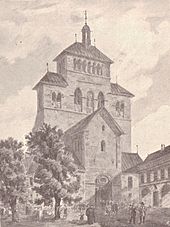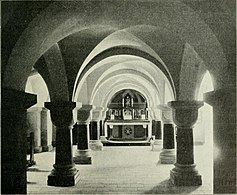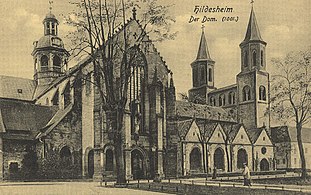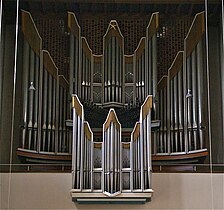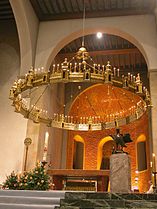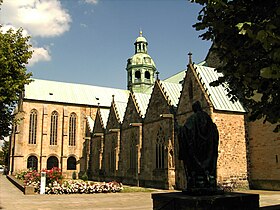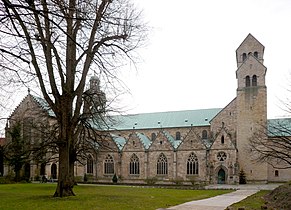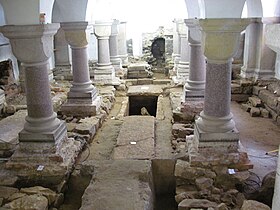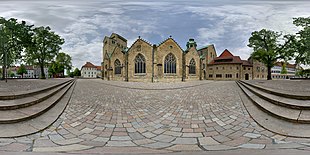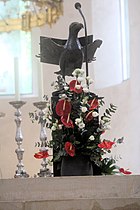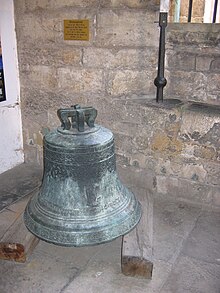Hildesheim Cathedral
The Hildesheim Cathedral , also called High Cathedral of Hildesheim or Mariendom of Hildesheim (official name High Cathedral Church of St. Mary of the Assumption ), is the cathedral of the Roman Catholic Diocese of Hildesheim in Hildesheim . It is one of the most important pre-Romanesque buildings in Lower Saxony and one of the oldest episcopal churches in Germany.
The first cathedral at this point was built in 872 on the so-called cathedral hill . The buildings and art treasures have been part of the UNESCO world cultural heritage since 1985, together with the Michaeliskirche under the name Dom and Michaeliskirche in Hildesheim . The building with its mighty west building and the crossing tower is characterized by predominantly Romanesque and Gothic components.
history
The construction
After the Diocese of Hildesheim was founded in 815, a Marienkapelle was built in the area of today's apse . To the south, Bishop Gunthar had one of St. Cäcilia , the basilica of modest dimensions with two high round towers, which served as the first cathedral and collegiate church and housed the graves of the first four bishops. Only remains of the foundations have been preserved from both buildings. An older Hildesheim parish church may have already existed in the chapel of St. Stephanus next to the gate building at the eastern entrance to the Hellweg, which could be traced back to Hildegrim von Chalons and his missionary work in Eastern Saxony. The Hildesheim Mariendom was built in 872 under Bishop Altfrid as a three-aisled basilica on a cross plan with a two-tier west building. The interior gives an early example of the Lower Saxony column change . In 1046 he suffered severe fire damage. Bishop Azelin intended to build a larger new building further west and had the nave demolished . His successor, Hezilo , gave up the new building plan and rebuilt the old foundations, including the walls that were still there. Further profound structural changes were made up to the 14th century, without deviating from the layout of the basilica by Bishop Altfrid. The side chapels on the north and south sides date from the Gothic period. The crossing tower and richly decorated interior , which were destroyed in 1945, date from the Baroque period . From 1840 to 1850 the dilapidated original west building was replaced by a neo-Romanesque double tower front, which existed until 1945.
The outlines of the cathedral courtyard surrounding the cathedral still show the structure of the Bernwardin cathedral castle. In the western extension of the axis of the cathedral stands the 11th century the bishop's residence as a government center of the Bishopric ; Until 1841 it was connected to the cathedral by an archway.
school and education
The Hildesheim Cathedral School , which had its rooms in the cloister , was one of the most important educational institutions of the Ottonian and Salian empires . The cathedral library that was built on it still exists today.
Hildesheim Cathedral before the Second World War
The rood screen in the cathedral until 1945
Destruction in World War II
The air raids on Hildesheim in World War II , the cathedral down to the west wing, the southern nave was arcade and the outer walls completely destroyed and had to rebuild the only cathedral in Germany newly ordained are. The crypt and the Laurentius Chapel from the 11th century have been preserved.
The sacred building was rebuilt in a simplified form between 1950 and 1960. Due to the high degree of destruction, the baroque interior concept was abandoned and a design was sought that refers to the assumed early Romanesque forms. The measure that was most visible from the outside was that the neo-Romanesque upper floors and flank towers of the west building from 1840 were removed and the old condition reconstructed, based on the west bar of the cathedral in Minden , for which the Hildesheim cathedral was once a model . The portal house in front of the west building was also demolished by about half. Otherwise the external appearance remained the same as before the destruction, in particular the baroque crossing tower was reconstructed.
The reconstruction took place using the simplest means. Because sandstone was in short supply after the war, the floor was laid with marble . The ceilings of the nave and the aisles and transepts were cast in concrete and boarded up from the inside to give the impression of flat beamed ceilings. The inner walls as well as the walls of the nave were built with hollow bricks or sand-lime bricks, faced on the outside with natural stone masonry that was extracted from the rubble and plastered smooth on the inside. The floor level was increased by 60 cm, which resulted in a compact impression, especially in the side aisles. The pillars of the northern nave arcades were cast from concrete and the pillars faced with sandstone.
The "Hildesheim Cathedral Controversy" in particular had a delaying effect, which is why the completion and re-consecration could only take place in 1960. The Diocese of Hildesheim and the State of Lower Saxony fought over the cost of the reconstruction, more precisely over the question of whether Lower Saxony was a legal successor to the Free State of Prussia , which at the time, as the Kingdom of Prussia , had taken over the cathedral construction in 1803 as part of the Reichsdeputationshauptschluss . The dispute was a 1957 comparison settled.
Hildesheim Cathedral before the renovation by 2010
Cathedral renovation 2010–2014
After years of preliminary planning, an extensive renovation of the cathedral began in January 2010 for the first time since 1960. In addition to technical and conservation measures, design changes were also carried out. The floor was lowered to the original level, the Hezilo and Thietmar chandeliers were given their places in the nave and high choir, and the Bernward door was hung with the picture side facing outwards behind an anteroom as intended. In addition, a bishop's crypt was created. The new Hildesheim Cathedral Museum , which opened on April 17, 2015, was built in the former St. Antonius Church and parts of the cathedral cloister on the southern arm of the transept of the cathedral .
The cathedral was closed on January 10, 2010. As in the post-war years, St. Godehard's basilica served as the episcopal church during the renovation work . The solemn reopening of the cathedral took place on August 15, 2014, at the same time as the opening of the 1200th anniversary of the diocese in 2015. The cathedral was until then the largest church construction site in Germany.
In addition to the cathedral renovation, the cathedral courtyard was also redesigned at the same time.
Archaeological finds
During excavations during the cathedral renovation from 2010, the foundations of the Lady Chapel from the early 9th century and an equally old cemetery to the west and south of it were found. 20 graves and the remains of buried people were uncovered, including in August 2012 the skeleton of a young woman who died around 800 with glass beads - the remains of a necklace - and a small knife as grave goods. It is the oldest completely found burial in Hildesheim Cathedral.
description
The basic structure of Hildesheim Cathedral is a three-aisled Romanesque basilica with a transept. The central nave and the side aisles of the nave are separated from each other by nine arcades in the typical Lower Saxon column alternation. A total of nine Gothic side chapels are attached to the outside of the aisles. A so-called west bar is in front of the nave on the west side ; To the east, a transept adjoins the nave , to which the so-called Northern Paradise was built on the north side. In the axis of the central nave on the east side of the transept is the Romanesque choir square , which ends with a semicircular apse . The crypt of the cathedral is located under the crossing and the choir .
Technical specifications
- Total length: 77 m
- Height of the central nave: 14 m
- Width of the central nave: 12 m
- Width of the nave: 32 m
- Height of the west bar: 41 m
- Height of the crossing tower: 20 m
Components
Westriegel
The Romanesque west building is of the Saxon west bar type . In the history of the cathedral, the western front has been redesigned several times. The first western block was built by Bishop Godehard. With the reconstruction after the fire of 1046, Bishop Hezilo redesigned the western bar. This served as a model for the west facade of Minden Cathedral and later also for the neo-Romanesque Bernward Church in Hildesheim. To the west of the west building were the Simon and Jude Chapel and the Chapel of St. Bernward, south of the New Year's Eve chapel. A roof turret came from the baroque period .
The west block from the time of Hezilo was demolished in 1840 due to cracks in the masonry and replaced by a double-towered, neo-Romanesque west building based on the model of the Hildesheim Godehardikirche . This west facade existed until March 22, 1945. When the cathedral was rebuilt after the Second World War, the neo-Romanesque west building was redesigned based on the model of the Hezilo cathedral, which gives it today's appearance. To the west of the transom is a vestibule with the Bernward door, and the upper floors of the west building house the 12-part bell of the cathedral.
Nordparadies and Steinberg Chapel
The Gothic Northern Paradise was built in 1412 as a representative city-side entrance to the cathedral in front of the north facade of the transept. The Steinberg Chapel borders the northern paradise to the east. It houses the remains of wall paintings , which probably depict the cathedral patrons and other saints . Both the Northern Paradise and the Steinberg Chapel were spared the destruction caused by the bombing raid on Hildesheim on March 22, 1945. The former Godehardichor is located on the upper floor of the Northern Paradise; it is used today as a rehearsal room for cathedral music.
Crossing tower
The first crossing tower of Hildesheim Cathedral consisted of a wooden construction. This was replaced by a three-story stone tower under Bishop Bernhard I in 1150 . Today's crossing tower is a reconstruction of the baroque tower that was destroyed in the Second World War.
Cloister
The cloister of Hildesheim Cathedral encloses the east apse of the cathedral with its three wings . It is one of the few cloisters in Germany that has an upper floor. The Annenkapelle was built in the center of the courtyard in 1321 as a place for commemorations. It is the first purely Gothic church in Hildesheim. The upper floor of the cloister is accessible to the public via the cathedral museum. Before that, it was only open on special occasions. The Anne Chapel is surrounded by the so-called Anne Cemetery. The former cathedral school (today the cathedral foyer) and a small chapel with a glass sculpture commemorating the destruction of the cathedral in World War II border the cloister in the north, the Godehard Hall in the east and the Laurentius chapel (today the Sacrament Chapel with Tabernacle) and the former Antonius Church (today part of the Cathedral Museum).
crypt
The cathedral crypt, built in 872 and redesigned several times in the following centuries, is one of the oldest in Germany. Around the crypt there was a crypt from 872, of which only the two entrances are left. It is located under the crossing and the choir of the cathedral and has a floor area of 251 m² and a height of approx. 3 m. At the place of the crypt there was initially the Marienkapelle built by Ludwig the Pious from around 815. Today the Godehard shrine, an altar, a statue of Mary and the Hildesheim founding reliquary are set up in the crypt. The roots of the rose bush can be viewed through a window on the east side.
Episcopal Crypt
At the western end of the crypt is the cathedral's new bishop's crypt, which was created between 2010 and 2014 as part of the renovation. It has 24 grave sites, three of which are currently occupied. So far, Joseph Godehard Machens , Heinrich Maria Janssen and Josef Homeyer have been buried here . A Romanesque crucifix is attached to the west wall of the crypt; Hildwin's grave, which was discovered during the excavations, is placed in the center of the room .
Side chapels
The Gothic side chapels are added to the north and south sides of the nave.
In the north, from west to east, are the George Chapel , the Chapel of the Ten Thousand Martyrs and the St. Matthew Chapel . Since the renovation from 2010 to 2014, the St. Matthew Chapel has provided space for the choirs of Hildesheim Cathedral Music, and the choir organ is also installed here. There are two confessionals in the Martyrs Chapel .
Located on the south side of the nave, the Barbara chapel, Vincent - and Anastasius chapel, Elisabeth chapel and the Immaculata chapel. The Barbara chapel houses the only almost completely preserved altar of the baroque cathedral furnishings; the altarpiece shows the donor together with the cathedral cartridges. In the Vinzenz and Anastasius Chapel there is a showcase in which baroque vessels for the sacred oils are kept. The cathedral's crib is set up in the Elisabeth Chapel for Christmas .
Furnishing
The furnishing of the Hildesheim Cathedral has grown over centuries. The bronze casts from the time of Bishop Bernward (993-1022) are world famous and part of the UNESCO World Heritage :
- The Bernward door from 1015, in the west porch
- The Christ column from 1020, erected in the south arm of the transept
Other works of art in the cathedral are:
- The Hezilo chandelier , 11th century, hanging in the central nave
- The Thietmar or Azelin chandelier , 11th century, hanging in the chancel
- The Shrine of Epiphanius or Shrine of the Cathedral Patrons, first half of the 12th century, set up in the northern niche of the eastern wall of the transept ( shrine with relics of St. Epiphanius of Pavia , Cosmas, Damian and Cantius, Cantianus and Cantianilla ). Below the niche is the Cecilia Chapel the head reliquary of St. Cecilia .
- In the southern niche of the eastern transept wall is the head reliquary of St. Bernward.
- The Godehard shrine, around 1140, placed in the crypt (shrine with relics of St. Godehard )
- The Hildesheim Marian reliquary in the crypt
- The eagle lectern , approx. 1220 (original in the cathedral museum; copy in liturgical use), to the right of the people 's altar designed by Ulrich Rückriem in the crossing
- The Romanesque bronze baptismal font from 1225, placed in the center aisle of the main nave
- The Gothic " Inkwell Madonna ", around 1430, erected on the northwestern crossing pillar
- The Irmensäule , also called Mariensäule , in the apse of the choir room, which carries a modern cross made of rock crystal (originally probably an Easter candlestick ; according to legend, the shaft of the column should consist of the core of the Irminsul )
- A pietà and a wrought-iron grille from the Baroque period in the St. George's Chapel
- A baroque side altar in the Barbara chapel
- Two alabaster figure of the prophet Isaiah and the deacon Philip , 18th Century, in the Vinzenz- and Anastasiuskapelle
- Painting of the Adoration of the Magi by Peter Paul Rubens , 18th century, in the Elisabeth Chapel
- Two former altar figures of Paul Egell that Anna and Joachim represent the 18th century, in the Immaculatakapelle
After the destruction in World War II, a modern tabernacle by the goldsmith and Benedictine nun Lioba Munz , which is now installed in the adoration chapel, a window in the apex of the choir apse, which showed Mary as an apocalyptic woman , and a mosaic in the dome of the choir apse, which reminded of the war destruction of Hildesheim and had the apocalyptic world fire as its motive. Above the mosaic was the psalm word Ps 104,30 EU Et renovabis faciem terrae, alleluia - And you renew the face of the earth, Hallelujah . The last two works of art were not incorporated into today's cathedral design as part of the renovation in 2010–2014.
Some of the cathedral's former furnishings and numerous liturgical implements and reliquaries make up the collection of the cathedral museum . This includes:
- The Bernward Cross
- The central panel of the Wrisberg epitaph , around 1585
- The former Domlettner from 1546
Outside the cathedral are:
- The tomb of the priest Bruno , 12th century, south outer wall of the choir
- The Bernwards monument by C. F. Hartzer , 1893, on the north side of the cathedral
Cathedral organs
The history of the organs in Hildesheim Cathedral can be traced back to the 14th century. As early as 1378 there was an organ in the north aisle above the Chapel of the Three Kings. This instrument was moved to the Godehardichor above the Northern Paradise in the 15th century and sold in 1713.
The first large organ was probably built by Conrad Abtt ( Minden ) in 1616/1617. The instrument had 31 stops on two manuals and a pedal . At the end of the 17th and beginning of the 18th century, the instrument was rebuilt and expanded several times. In 1909 Furtwängler & Hammer (Hanover) built a new organ with 54 stops on three manuals and a pedal while retaining the prospectus from 1617. This instrument was destroyed in a bomb attack on March 22nd, 1945.
Organ 1960 to 2010
In the course of the reconstruction of the cathedral, Franz Breil ( Dorsten ) built a new organ with 52 registers on four manuals and pedal in 1960, including three horizontal reed registers ("Spanish trumpets") in the prospectus. In 1989 the instrument was modified by the Klais company ( Bonn ) and expanded to 66 registers.
|
|
|
|
|
|||||||||||||||||||||||||||||||||||||||||||||||||||||||||||||||||||||||||||||||||||||||||||||||||||||||||||||||||||||||||||||||||||||||||||||||||||||||||||||||||||||||||||||||||||||||||||||||||||||||||||||||||||||||||||||||||||||||
- Coupling : All normal coupling, Sub III, Sub III / II, Tr / II, Tr / IV, Tr / P.
- Playing aids : 512-fold setter , roller .
Seifert organs (2014)
In the course of the renovation of the cathedral, Orgelbau Romanus Seifert & Sohn (Kevelaer) built a new main organ with 77 registers on four manuals and pedal, reusing parts of the previous instrument (including several wind chests, 56 registers and the console's chassis). In addition, a new choir organ with 16 registers was built in the left aisle.
|
|
|
|
|||||||||||||||||||||||||||||||||||||||||||||||||||||||||||||||||||||||||||||||||||||||||||||||||||||||||||||||||||||||||||||||||||||||||||||||||||||||||||||||||||||||||||||||||||||||||||||||||||||||||||||||||||||||||||||||||||||||
|
|
|
|
|
||||||||||||||||||||||||||||||||||||||||||||||||||||||||||||||||||||||||||||||||||||||||||||||||||
-
Pairing :
- Normal coupling: III / I, IV / I, I / II, III / II, IV / II, IV / III, I / P, II / P, III / P, IV / P.
- Sub-octave coupling: III / I, IV / I, III / II, IV / II, III / III, IV / III.
- Super octave coupling: III / I, IV / I, II / II, IV / II, III / III, IV / III, III / P.
- annotation
- S = Seifert (2014).
- K = Klais (1989).
- (P) = in the prospectus.
- (*) = Register of the small pedal with tremulant.
To accompany the choir, which is now involved in the liturgical design in the front area of the cathedral, a choir organ with 16 registers was built in the left aisle . It does not have its own console, but can be played both from the console of the main organ and from the movable console in the nave. The console of the main organ has mechanical keyboard and electrical stop actions; the coupling IV-II and I-II are optionally mechanical or electrical. The mobile electric general console in the nave has an additional "Equallage from" switch for each part of the work as well as an electrically height-adjustable pedal board. Both gaming tables have, among other things, a BUS system with freely editable and dynamic links as well as midi and recording functions.
|
|
|
||||||||||||||||||||||||||||||||||||||||||||||||||||||||||||||||||||||||||
- All normal paddocks
- annotation
- (P) = in the prospectus.
Bells
The bell before the Second World War
Up until the Second World War, the cathedral had 16 chiming bells and clock strikes. The basis of the pre-war bells were five large bells with the striking notes f sharp 0 , a 0 , c sharp 1 , f sharp 1 , g sharp 1 .
Of the pre-war bell, nine orchestras survived the war; the large Godehards bell in the west tower was so badly damaged in an air raid that it could no longer be rung. The Bernwards bell was in the bell cemetery in Hamburg, but had been irreparably damaged during transport.
A total of two sound bodies were available for reuse: On the one hand, the historic Apostolica bell from 1765 by the foundry Johann Martin Roth (Mainz), which was to be integrated into the new cathedral bells, and another historic bell, the Nikolaus -Bell from 1766, by the bell founder Johann Martin Roth (Mainz), which was initially hung in the crossing tower, and was last exhibited in Nordparadies until 2010.
| No. |
Surname |
Casting year |
Caster |
∅ (mm) |
Weight (kg) |
Nominal (16th note) |
inscription | annotation |
|---|---|---|---|---|---|---|---|---|
| I. | Cantabona ( Maria ) | 1875 | Carl Louis Hermann Große | ? | 8415 | f sharp 0 | JOHANN MARTIN ROTH CHVRMAYNTZISCHER ARTILLERIE OBERLIEVTENANT HAS CASTED VNS IN HILDESHEIM, ANNO 1765. - MARIAE DE IPARAE PATRONAE H VIVSECCLES IAE ET PATRIAE | Cast from the Marienbell, cast in 1765 by Johann Martin Roth from Mainz. |
| II | Apostolica | 1765 | Johann Martin Roth, Mainz | 1946 | 4895 | a 0 | JOHANN MARTIN ROTH VON MAINTZ CAST ME IN HILDESHEIM ANNO 1765. - APOSTOLIS PETRO ET PAVLO COM PATRONIS HILDESIENSIB VS. | Reused in the new peal of 1960. Conversely True to as 0 . see below |
| III | Godehard | ? | ? | cis 1 | SANCTO GODEHARDO PRÄESVLI HILDESIENSI ET PATRONO TVTELARI. | |||
| IV | Bernward | ? | ? | f sharp 1 | DIVO BERVARDO EPISCOPO HILDESIENSI AC PATRONO. | |||
| V | Nicholas | 1766 | 950 | 550 | g sharp 1 | SANCTO NICOLAO EPISCOPO, DEFENSORI FIDEI CATHOLICAE IN NECESSITATE OPITVLATORI. |
Reformed in 1960
After the Second World War it was planned to create a 12-part cathedral bell, with six large bells in the west tower and six small (right) bells in the crossing tower (planned chimes: g 1 , b 1 , c 2 , es 2 , f 2 and g 2 ).
Initially, however, only a six-part bell was implemented. In 1960, the bell founder Friedrich Wilhelm Schilling (Heidelberg) cast five new bells, which - together with the historical Apostolica bell from 1765 as the second deepest bell - were placed in the west tower. On the lower bell chamber of the tower hung the three lowest clay (bells 1–3), in the bell chamber above the smaller three (bells 4–6). The new bell was set a semitone lower than the original bell - in coordination with the bells of the surrounding churches. Therefore, the Apostolica bell had to be tuned a semitone lower to match the new bells.
Since all the clock bells had been destroyed in World War II, the quarter-hour strike of bell number 5, the hour strike of bell number 4, and the angelus strike of bell number 1. Bell number 6 served as the angelus bell.
Expansion 2013/2014
In the course of the restoration of the cathedral in 2010–2014, the peal was extended by six bells to a 12-part peal, as planned at the beginning of the 1960s. However, the tone sequence planned at that time was slightly deviated from. The new cathedral bells are named after witnesses of faith who enjoy special veneration in the Hildesheim diocese. Bell 8 reminds us of Bishop Altfrid, one of the most important bishops of the Hildesheim diocese, who built the cathedral on the plan that still exists today. Bell 9 commemorates Hedwig von Schlesien, patroness of the expellees, many of whom came to the Diocese of Hildesheim after the Second World War and had a decisive influence on it. Martin von Tours (bell 7) represents the Eichsfeld. Niels Stensen as auxiliary bishop in Hanover and Edith Stein as a student in Göttingen (bells 11 and 12) lived and worked in today's diocese area. Irish martyr bishop Oliver Plunkett (bell 10) is especially venerated in Lamspringe, where his bones rest.
In 2013 the old belfry in the upper belfry was dismantled and replaced by a new belfry made of oak. It takes the six new bells and also houses part of the existing bells. The deepest bells were hung in the lower bell chamber.
On November 16, 2013, the new bells were cast by the Bachert bell foundry (Karlsruhe). Bishop Norbert Trelle celebrated the consecration of the bells in front of the cathedral on May 14th, 2014. For the first time, the bells rang out when the cathedral reopened on August 15th, 2014.
Since 2015, a one-hour bell concert with all 12 bells has been taking place on August 14, the evening before the solemnity of Mary's Assumption into Heaven .
With a number of twelve bells and a total weight of 24.724 tons, the Hildesheim cathedral bells are the bells-richest bells in Hildesheim and thus also the largest (besides the bells of the Brunswick cathedral ) and heaviest church bells in Lower Saxony.
| No. | Surname | Casting year | Foundry, casting location |
Ø (mm) |
Weight (kg) |
Nominal ( HT - 1 / 16 ) |
inscription | Belfry |
| 1 | Cantabona ( Maria ) | 1960 | Friedrich Wilhelm Schilling , Heidelberg | 2315 | 8686 | f 0 +5 | CANTATE DOMINO CANTICUM NOVUM QUIA MIRABILIA FECIT SANCTA MARIA CANTA BONA NOBIS! - Auxilio Matris DNJCh. confidens me fudit FW Schilling Heidelbergensis Anno Domini MCMLIX ("Sing to the Lord a new song, because he has done wonderful things. Holy Mary, sing us good news! Trusting in the help of the mother of our Lord Jesus Christ, FW Schilling from Heidelberg welcomed me to the Years of the Lord cast in 1959. ") |
Westriegel, below |
| 2 | Apostolica | 1765 | Johann Martin Roth, Mainz | 1946 | 4895 | as 0 +5 | Johann Martin Roth von Maintz cast me in Hildesheim in 1765, APOSTOLIS PETRO ET PAULO COMPATRONIS HILDESIENSIBUS ("The fellow patrons of Hildesheim, the apostles Peter and Paul") |
|
| 3 | Bernward | 1960 | Friedrich Wilhelm Schilling, Heidelberg | 1699 | 3366 | b 0 +4 | SIT PIA PAX ET VOS AMEN CANITE SANCTE BERNWARDE ORA PRO NOBIS (“May holy peace be, and you sing the amen to it. St. Bernward, pray for us!”) |
|
| 4th | Godehard | 1502 | 2278 | c 1 +4 | STAR RESISTENTES / STANTES REGE / GREAT JACENTES. SANCTE GODEHARDE ORA PRO NOBIS ("Overthrow the defiant / rule the standing / raise the lying. Holy Godehard, pray for us!") |
Westriegel, above | ||
| 5 | Epiphanius | 1258 | 1343 | it 1 +6 | EPIPHANIUS PACIFICATOR PATRONUS EPIPHANIAM DOMINI NUNTIAT. SANCTE EPIPHANI PRECARE PRO NOBIS ("Epiphanius, the peacemaker, proclaims the apparition of the Lord as patron. Saint Epiphanius, pray for us!") |
|||
| 6th | Cecilia | 1156 | 1068 | f 1 +4 | CANTANTIBUS ORGANIS CAECILIA DOMINO DECANTABAT! SANCTA CAECILIA ADJUVA NOS ("Under the sound of the organ, Cecilia sang the praises of the Lord. Saint Cecilia, ask us for help!") |
|||
| 7th | Martin of Tours | 2013 | Bachert, Karlsruhe | 1076 | 917 | g 1 +3 | HIC EST FRATRUM AMATOR + QUI MULTUM ORAT PRO POPULO (“This is the friend of his brothers who prays a lot for the people”) SANCTE MARTINE + ORA PRO NOBIS (“Saint Martin, pray for us”) |
|
| 8th | Altfrid | 1009 | 767 | as 1 +6 | INTERCESSIONE SANCTI EPISCOPI ALTFRIDI SUFFULTA + DIOECESIS NOSTRA FIRMA IN FIDE MANEAT ("Supported by the intercession of St. Bishop Altfrid, our diocese remain firmly in faith") |
|||
| 9 | Hedwig | 896 | 521 | b 1 +6 | BEATAE HEDVIGIS INTERCESSIO TRIBUAT POPULIS POLONIAE ET GERMANIAE CAELESTE SUBSIDIUM ("The intercession of Blessed Hedwig obtain heavenly assistance for the peoples of Poland and Germany") |
|||
| 10 | Oliver Plunkett | 792 | 357 | c 2 +5 | PROBASTI NOS + DEUS + ET EDUXISTI NOS IN REFRIGERIUM (“You tried us, God, but you led us out and refreshed”) SANCTUS OLIVERUS PLUNKETT + RECONCILIATIONIS EXEMPLUM + EPISCOPUS ET MARTYR + ADIUVET NOS (“Saint Oliver the Plunkett, model Reconciliation, bishop and martyr, help us ") |
|||
| 11 | Niels Stensen | 733 | 294 | it 2 +7 | PULCHRA QUAE VIDENTUR + PULCHRIORA QUAE SCIUNTUR + LONGE PULCHERRIMA QUAE IGNORANTUR ("What we see is beautiful, what we know is more beautiful, what we do not understand is most beautiful") BEATE NICOLAE STENSEN + ORA PRO NOBIS ("Blessed, please, Niels for us") |
|||
| 12 | Edith Stein | 671 | 232 | f 2 +6 | CRUX EXALTATUR + UT CAELUM OSTENDAT ("The cross rises and points upwards") SANCTA TERESIA BENEDICTA A CRUCE + ORA PRO NOBIS ("Saint Teresia Benedicta of the cross, pray for us") |
|||
| - | Nicholas | 1766 | Johann Martin Roth, Mainz | 950 | 550 | as 1 +2 | SANCTO NICOLAO EPISCOPO, DEFENSORI FIDEI CATHOLICAE IN NECESSITATE OPITULATORI. ("To the Holy Bishop Nicholas, the defender of the Catholic faith and benefactor in need") |
- |
Sagas and stories
The millennial rose bush
The church building is well known for the “ millennial rose bush ” that grows outside the cathedral building, on the outer wall of the apse , in the inner courtyard of the cloister. The exact age of the rose cannot be precisely determined. The present rose bush has been continuously attested for at least four hundred years. In any case, it is considered the oldest living rose in the world.
The legend of the rose bush cites the date 815. At that time, it is said, Emperor Ludwig the Pious had a mass read on a hunt in the middle of the forest , whereby the Marian reliquary he was carrying was hung on the branch of a wild rose. After the mass it could no longer be removed from the branch. In it the emperor saw the sign to found the new diocese here - and not, as planned, in Elze - and to consecrate it to Mary, the mother of God , whose symbol is the rose .
During the Second World War, high-explosive bombs and incendiary bombs damaged the cathedral and the apse with the rose bush on March 22, 1945. Only a charred stump of the rose remained under the rubble, and it was thought that the end of the famous rose had come. But the roots of the rose were largely undamaged. In the spring of 1945, 20 new shoots developed. The first flowers appeared in 1947, albeit only in small numbers. In 1948 the number of flowers was already 122. Since then, the new branches of the “Millennial Rose” have been marked with the year in which they grew again with small metal signs - as they were before the destruction. When the people of Hildesheim saw that the rose bush was developing new shoots, they took this as a sign of a good new beginning, and the importance of the rose as a symbol of the city increased.
Devil horn
At the southwest entrance is the cathedral's “devil's horn”, a horn-shaped, brownish discoloration in a sandstone block, around which several legends entwine.
World Heritage
In 1985 the Hildesheim Cathedral with the Michaeliskirche was declared a World Heritage Site by UNESCO . Three criteria for inclusion on the World Heritage List were considered to be met:
- Criterion (i): The bronze casts by Bernwards and the ceiling in St. Michael's Church represent a unique artistic achievement.
- Criterion (ii): St. Michael's Church has had a major impact on developments in medieval architecture.
- Criterion (iii): The St. Marien Cathedral and St. Michael Church in Hildesheim and their art treasures provide a better and more immediate overall understanding than any other decoration in Romanesque churches of the Christian West.
Hildesheim Cathedral as an underground slide
Before 2014, kestrels were breeding at the cathedral. A pair of owls has been breeding at the cathedral since 2014 .
See also
- List of Hildesheim cathedral preachers
- Cathedral Music Hildesheim
- Hildesheim Cathedral Chapter
- List of churches in Hildesheim
- List of churches in the Diocese of Hildesheim
- List of cathedrals and episcopal churches in Germany
- List of the UNESCO World Heritage Church buildings
literature
- Michael Brandt: Bernwards column - treasures from the Hildesheim cathedral. Schnell & Steiner, Regensburg 2009, ISBN 978-3-7954-2046-8 .
- Michael Brandt: Bernwards Door - Treasures from Hildesheim Cathedral. Schnell & Steiner, Regensburg 2010, ISBN 978-3-7954-2045-1 .
- Cathedral chapter Hildesheim (ed.): The Hildesheim Mariendom. Cathedral and World Heritage. Schnell & Steiner, Regensburg 2014, ISBN 978-3-7954-2917-1 .
- Bernhard Gallistl: Hildesheim Cathedral and its World Heritage Site, Bernward Door and Christ Column , Bernward Mediengesellschaft mbH, Hildesheim 2000, ISBN 3-89366-500-5 .
- Bernhard Gallistl: Narrated World Heritage. 12 centuries of Hildesheim. Olms, Hildesheim 2015, ISBN 978-3-487-15230-1 .
- Karin Heise: The rood screen of the Hildesheim Cathedral - The Sculpture Art of the Muenster Workshops 1535–1560 , 2 volumes, Hildesheim 1998 (= The Hildesheim Cathedral - Studies and Sources, Vol. 2.1 + 2.2).
- Claudia Höhl: The Wilbernus baptismal font - treasures from Hildesheim Cathedral. Schnell & Steiner, Regensburg 2009, ISBN 978-3-7954-2047-5 .
- Ulrich Knapp (Ed.), The Hildesheim Cathedral - Destruction and Reconstruction , (Catalogs of the Dom-Museum Hildesheim; Vol. 2), Michael Imhof Verlag, Petersberg (1999), ISBN 3-932526-48-1 .
- Ulrich Knapp (Ed.), EGO SUM HILDENSEMENSIS - Bishop, Cathedral Chapter and Cathedral in Hildesheim 815 to 1810. (Catalogs of the Cathedral Museum Hildesheim; Vol. 3), Michael Imhof Verlag, Petersberg (2000), ISBN 3-932526-74 -0 .
- Karl Bernhard Kruse (ed.), The Hildesheim Cathedral - From the Imperial Chapel and the Carolingian Cathedral Churches to the Destruction in 1945 (excavations and construction studies on the Cathedral Hill from 1988 to 1999). Hahnsche Buchhandlung, Hannover 2000, ISBN 3-7752-5644-X .
- Karl Bernhard Kruse (Ed.): The building history of the Hildesheim cathedral. Schnell & Steiner, Regensburg 2017, ISBN 978-3-7954-3208-9 .
- Annett Laube-Rosenpflanzer, Lutz Rosenpflanzer: churches, monasteries, royal courts. Pre-Romanesque architecture between the Weser and Elbe. Mitteldeutscher Verlag, Halle 2007, ISBN 978-3-89812-499-7 .
- Christine Wulf: The inscriptions of the city of Hildesheim , Volume 58 of the series The German inscriptions. Wiesbaden 2003, ISBN 978-3-89500-327-1 ; see: DI 58, City of Hildesheim, in: www.inschriften.net
Web links
- Homepage of the Hildesheim Cathedral
- World Heritage Hildesheim
- Hildesheim Cathedral Building Association
- Entry on the UNESCO World Heritage Center website ( English and French ).
Individual evidence
- ^ Bernhard Gallistl: The Sachsenland star. On Henry I's election as a king in Dinklar near Hildesheim. In: Concilium medii aevi 20, 2017, p. 178; https://cma.gbv.de/dr,cma,020,2017,a,04.pdf
- ↑ The Hildesheim Cathedral Museum , accessed on November 8, 2015.
- ^ Information from the diocese ( Memento from December 6, 2013 in the Internet Archive )
- ↑ The Thietmar chandelier on the Hildesheim Cathedral website, accessed on September 27, 2016
- ↑ Godehard shrine on the cathedral side
- ↑ Mariendom Hildesheim: The Irmensäule
- ↑ Information on the cathedral organ from 1960 .
- ^ History of the cathedral organ . www.dom-hildesheim.de. Accessed June 4, 2018.
- ↑ Information on the new organ system .
- ↑ To the dispositions ( Memento of December 6, 2013 in the Internet Archive ) (PDF; 35 kB) of the new organ.
- ↑ www.dom-hildesheim.de: The bells of Hildesheim Cathedral .
- ↑ New bells for Hildesheim Cathedral , www.wamsiedler.de, April 11, 2013.
- ↑ Information (PDF; 2.6 MB) from the diocese about the cathedral renovation.
- ↑ Bells cast for Hildesheim Cathedral , www.wamsiedler.de, November 18, 2013.
- ↑ Hildesheim (D) Cathedral of the Assumption of the Virgin Mary: New Bell (August 15, 2014, 4:15 pm - 5:00 pm) on YouTube .
- ↑ Bell concert rings in Dompatrozinium Mariae Himmelfahrt on YouTube , Diocese of Hildesheim, August 15, 2015.
- ↑ Concert of Hildesheim Cathedral Bells Heavy Metal open air , domradio.de, August 15, 2015.
- ↑ Cathedral Bell Concert in Hildesheim - A contribution by Jan Hendrik Stens , domradio.de, August 15, 2015.
- ↑ www.dom-hildesheim.de: Size and sound of the bells .
- ↑ Hildesheim: Teufelshorn am Dom. Diocese stories, Diocese Hildesheim .
- ↑ UNESCO: World Heritage List “St Mary's Cathedral and St Michael's Church at Hildesheim” , accessed on September 16, 2015.
- ^ Wilhelm Breuer: Stately falcons . Birds 3/2019, 18–23
- ^ Wilhelm Breuer: The eagle owls at Hildesheim Cathedral in 2015. Eulenrundblick 66: 41-42.
- ↑ Cathedral Eagle Owls. (No longer available online.) In: bistum-hildesheim.de. Diocese of Hildesheim, archived from the original on January 13, 2018 ; Retrieved July 6, 2017 . Info: The archive link was inserted automatically and has not yet been checked. Please check the original and archive link according to the instructions and then remove this notice.
Coordinates: 52 ° 8 ′ 56 ″ N , 9 ° 56 ′ 50 ″ E



